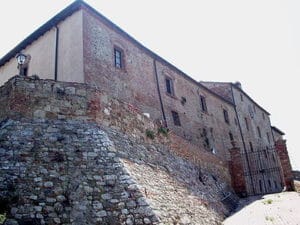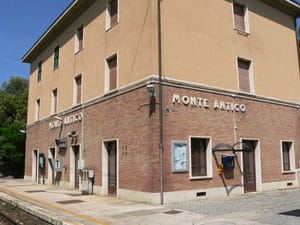Monte Antico è situato sopra un colle e si raggiunge attraverso una deviazione che si incontra sulla sinistra, poco dopo la stazione di Civitella Paganico, percorrendo la strada Leopoldina. Ai piedi del colle si trova la stazione ferroviaria della linea Siena-Grosseto e una chiesa in stile moderno.
Dal borgo di Monte Antico è possibile ammirare un incantevole panorama, che è certamente uno dei più interessanti della Toscana. Lo scenario è boscoso e collinare; in fondo, la vallata è attraversata dal fiume Ombrone.
Il castello
Sul colle, in posizione dominante, si trova il castello di Monte Antico.
Secondo gli storici, intorno all’anno 1000, la rocca e un’antica pieve appartenevano agli Ardengheschi.
Successivamente il borgo di Monte Antico e la rocca sono appartenuti a nobili famiglie senesi.
All’inizio del ‘300 i Buonsignori ampliarono la rocca e la trasformarono in un grande castello.
Alla fine del ‘300 il castello di Monte Antico divenne proprietà della famiglia Salimbeni, e poi del Comune di Siena; quest’ultimo, durante il ‘400, lo cedette alla famiglia Tolomei.
Pure se l’antica rocca è ancora salda sui primitivi bastioni, la struttura ha subito nel corso dei secoli molte ristrutturazioni .
Il castello di Monte Antico, sorto sopra la cinta muraria originaria medievale da cui è protetto, è composto da un fabbricato con pareti esterne intonacate, ristrutturate in epoca rinascimentale. Esso è appoggiato su un lato ad un altro fabbricato, costruito con pietre tipiche dell’epoca della sua prima costruzione.
Il castello di Monte Antico si presenta ad L con al centro un ampio cortile dove è ben visibile il pozzo con sottostante cisterna adibita alla raccolta dell’acqua piovana.
Dal cortile è possibile ammirare una serie di arcate in cotto e la scala di accesso più volte rimaneggiata al fine di conservare e tramandare lo stile romanico-gotico-rinascimentale.
La facciata esterna del castello, che guarda verso la Maremma, è una grande parete con finestre bifore di epoca successiva rispetto al basamento a scarpata, appartenente al primo nucleo medievale.
 Monte Antico is located on a hill and can be reached via a detour that meets on the left, just after the Civitella Paganico station, along the Leopoldina road. At the foot of the hill is the train station of the Siena-Grosseto line and a modern-style church.
Monte Antico is located on a hill and can be reached via a detour that meets on the left, just after the Civitella Paganico station, along the Leopoldina road. At the foot of the hill is the train station of the Siena-Grosseto line and a modern-style church.
From the village of Monte Antico it is possible to admire an enchanting panorama, which is certainly one of the most interesting in Tuscany. The scenery is wooded and hilly; at the bottom, the valley is crossed by the Ombrone river.
The Castle
On the hill, in a dominant position, is the castle of Monte Antico.
According to historians, around the year 1000, the fortress and an ancient parish church belonged to the Ardengheschi family. Subsequently the village of Monte Antico and the fortress belonged to noble Sienese families.
At the beginning of the 14th century the Buonsignori enlarged the fortress and turned it into a large castle.
At the end of the 14th century the Monte Antico castle became the property of the Salimbeni family, and then of the Municipality of Siena; the latter, during the fifteenth century, ceded it to the Tolomei family.
Even if the ancient fortress is still firm on the primitive bastions, the structure has undergone many renovations over the centuries. The castle of Monte Antico, built above the original medieval walls from which it is protected, is composed of a building with plastered external walls, renovated during the Renaissance. It is placed on one side of another building, built with stones typical of the time of its first construction. The castle of Monte Antico is L-shaped with a large courtyard in the center where the well is clearly visible with the underlying cistern used for collecting rainwater. From the courtyard it is possible to admire a series of terracotta arches and the access staircase, reworked several times in order to preserve and pass on the Romanesque-Gothic-Renaissance style. The external façade of the castle, which faces the Maremma, is a large wall with mullioned windows of a later period than the basement of the escarpment, belonging to the first medieval nucleus.

